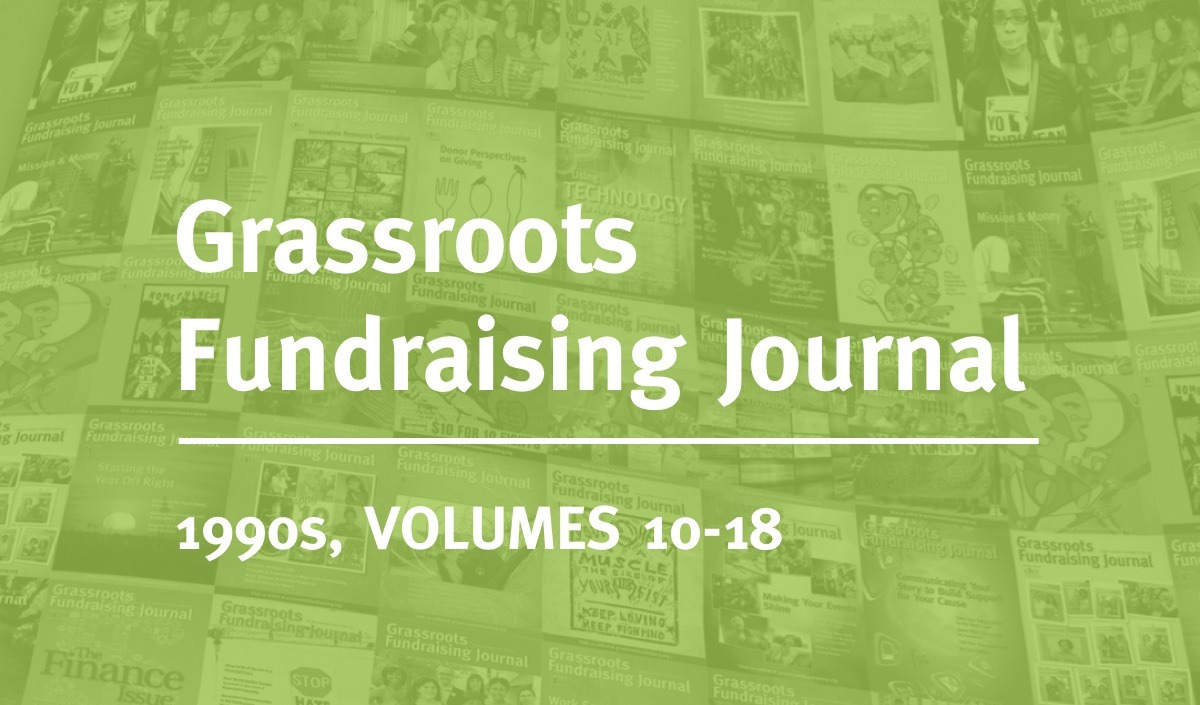
Editors’ note: This article, first published in print during August-1997, has been republished for Nonprofit Quarterly with minor updates.
In 1980, a few weeks after Ronald Reagan was elected president, I answered a classified advertisement in the Portland Oregonian. The first word was ACTIVIST. I can’t remember the rest of the ad, but the main idea was that I would get paid to work for social justice. I was adrift and anxious about the future, and this seemed to me a small, tangible miracle.
The next day I was sitting on a cracked vinyl sofa, waiting for my interview. The linoleum was streaked with dirt and a pile of dead office machines (remember mimeographs?) rusted quietly in the corner, people ran in and out with picket signs, a typewriter (remember typewriters) chattered in the back room, and I overheard an argument in with the word “tactics” played a big role. I didn’t know that was going on, but I wanted in.
That night I started knocking on doors, asking strangers for money to fight the utility company. I was -surprised! -a fundraiser. By the time I left Oregon fair share in 1983, I had canvassed thousands of homes and given my pitch ten thousand times. I received lots of trainings in community organizing and tactical research, but my doors -to-doors experience – talking with people about a better world and asking them to help pay for it – was the most compelling, frustrating and empowering part of the job.
Almost every day, I am reminded of lessons learned while canvassing. As you go forward with your fundraising program- writing grant proposals, designing direct mail appeals, meeting with major donors, and so on – keep these points in mind.
1.Don’t waste your time on lost causes. Our crew leaders had a favorite expression: “canvass with your feet, not your mouth.” Rather than waste time talking with marginal prospects. I was encouraged to make a quick evaluation, offer a polite “thanks your time,” and move on to the next house.
All successful fundraising is based on targeting. Spend the most time, efforts and money on your best prospects.
2. You want a dialogue, not a monologue. Our canvass “raps’ included periodic questions. ”Are you concerned about these issues? What have you heard about our work? How would you like to be involved? If the prospect responded with a black stare or an unenthusiastic answer, it was time to head for the next door.
This lesson had important implications for all face- to-face fundraising, especially asking for major gifts. Many novice solicitors are so focused on the needs of the organization, they forget about the needs and interests of the donors. To be an effective fundraiser, you must be a good listener.
3. Craft the pitch to meet the needs of the individual. I always mentioned two or three current issues to see which, if any, touched a live wire. If I got a bigger response on utility rates then community reinvestment (“Am I concerned about utility rates? Look at this,” he said, displaying shut-off notices from the electric, gas, and water companies), then I talked about our efforts to reform the public utility commission.
Sign up for our free newsletters
Subscribe to NPQ's newsletters to have our top stories delivered directly to your inbox.
By signing up, you agree to our privacy policy and terms of use, and to receive messages from NPQ and our partners.
If you don’t Identify and promote the right “product” for each individual, you won’t get the sale(_donation).
4. Tell the truth. it’s hard work finding the right people, figuring out what each one specifically wants, and providing it. You might get frustrated. And when you are frustrated, it’s easy to stretch the truth by embellishing your organization’s track record of promising extra benefits to the prospective donor.
After knocking 40 doors- an average night’s work -I was often tempted to say the first thing that came into my head. To edit myself, I tried to remember that someone- maybe me- would be knocking on that same door in a year. We had to be accountable to that particular individual.
When you stretch the truth, it was a way of wrapping itself around your neck. Never promise more than you can deliver.
5. The stronger the relationship, The larger the gift. “As the old cliché goes, people give money to people, not organizations.” My favorite canvassing moments came while visiting members I had signed up during a previous circuit through the neighborhood. These people often remembered my name, invited to me, and renewed their membership at a higher rate.
This is the power of fundraising: people give you their money freely, then thank you for doing good things with it. Their trust is strengthened as they get to know you, and your organization, on a personal basis.
6. Hermits need not apply. I trained a few well-meaning folks who had the right politics for the job but were basically loners. They lasted a few days, then quit. No surprise — canvassing, like all fundraising, is about people.
If you don’t like people, fundraising is the wrong line of work. However, if you genuinely enjoy other human beings, you’ve passed the first and most important test of a successful fundraiser.
Andy Robinson is a trainer and consultant in Tucson, Arizona. His book, Grassroots Grants: An Activist’s Guide to Proposal Writing, is available from Chardon press (see page 15). This article first appeared in Shelter force.









